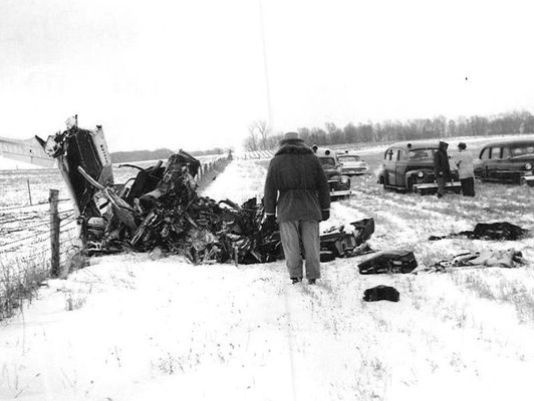![635610668317312936-635610643392512400-B9316459196Z.1-20150303194622-00...[ID=24372001] ID=24372001](http://www.gannett-cdn.com/-mm-/3da1b5202fbd0a8e369fdca7db0f971d9afe4ea2/c=32-0-501-401/local/-/media/2015/03/04/KVUE/KVUE/635610668317312936-635610643392512400-B9316459196Z.1-20150303194622-000-G6UA472UL.1-0.jpg) CLEAR LAKE, Iowa -- It was labeled "the day the music died," but speculation has lived on about the cause of the airplane crash near Clear Lake that killed rock 'n' roll legend Buddy Holly and three others in 1959.
CLEAR LAKE, Iowa -- It was labeled "the day the music died," but speculation has lived on about the cause of the airplane crash near Clear Lake that killed rock 'n' roll legend Buddy Holly and three others in 1959.
The Civil Aeronautics Board ruled on Sept. 23, 1959, that the crash's cause was pilot error and deficiencies in the weather briefing to the pilot. But 56 years later, officials with the National Transportation Safety Board say its cold case unit is considering reopening the investigation.
L.J. Coon, a New England man who describes himself as a retired pilot, aircraft dispatcher and Federal Aviation Administration test proctor, petitioned the NTSB to look at several possible contributing factors that may clear the name of pilot Roger Peterson, who died in the crash at age 21.
"You have gotten our attention," the NTSB wrote to Coon in a Feb. 19, 2015, email, promising to look into information that he provided. A decision on whether to reopen the case could take several weeks.
Holly has become such a legend that for decades legions of fans have flocked to the crash site seven miles north of Clear Lake, where an annual party is held at the Surf Ballroom on the crash anniversary.
It's unclear what factors caused the NTSB to entertain reopening the case or how often the agency does so.
"Our cases are never closed, and we get these from time to time," said NTSB spokesman Eric Weiss. "The key is if there is new information not previously considered by the board."
Coon said via email that he investigated the crash to uncover information that could "save lives" in future flights.
He mainly wants to know whether control may have been lost due to inoperable right side rudder pedals and to inquire about readings on the fuel gauge. There was no fire after the crash or fuel smell reported at the site.
"I believe that the NTSB will review pilot Peterson's diagnostic actions in the aircraft during this 3.5-minute flight and realize the heroic efforts that took place in those 4.9 miles," Coon said.
Those actions may have included trying to glide the plane to a landing and flare it just before its right wing hit the ground, causing the plane to tumble and crash.
The Dwyer Flying Service hired Peterson for the flight and later faced a lawsuit from the family of Ritchie Valens, who was killed along with fellow musician J.P. "The Big Bopper" Richardson.
"I disagree with the gentleman," said Barb Dwyer of Clear Lake, who worked at the service with her husband, Jerry, who is suffering health problems. "They come out of the woodwork this time of year with theories."
The events of that Feb. 3, 1959, night have been the subject of numerous books.
Dion DiMucci of Dion and the Belmonts told the Register in 2009 that Buddy Holly told the musicians that night to flip a coin to see who would fill the three seats of the four-seat Beech Bonanza aircraft after the concert at the Surf Ballroom in Clear Lake and who would have to go on the bus.
But Waylon Jennings, then a young bass player who would later find fame in country music, gave up his won seat to Richardson, who was battling a fever. After the airplane crashed, the guilt over the decision would dog Jennings for his entire life.
In the months and years that followed, speculation abounded about the discovery of a gun at the crash site, rumors of disputes between the musicians and other matters.
Light snow was falling, with gusty winds, when the airplane took off and flew into a remote area of darkness where there was no definite horizon, requiring the pilot to rely solely on flight instruments he was not experienced with, according to the accident report.
A key part of the aeronautics board findings, Coon said, was that the right wing hit the ground with the nose lowered only slightly, indicating that "some control was being affected at the time." Another factor may have been an improper weight distribution on the airplane, which would cause the plane to be more difficult to control.
Urbandale author Larry Lehmer said he studied the in-depth investigation file for the crash while compiling his book, "The Day the Music Died," and is convinced the pilot suffered vertigo.
"The pilot was not qualified to fly on instruments at all," he said. "When you get flying in that remote part of the state, there isn't much ground reference, and it's hard to tell up from down."
Jerry Dwyer told the Register in 2009 that he would clear up the factors behind the crash by supplying new information in a book. Barb Dwyer declined further comment on the forthcoming book or the crash.


